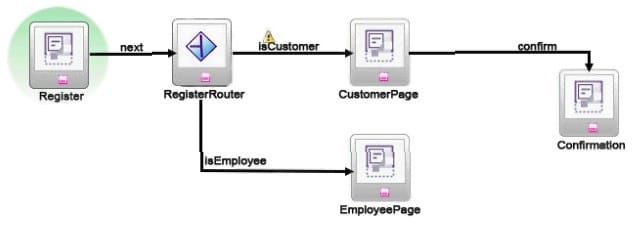Exam Details
Exam Code
:1Z0-419Exam Name
:Implementation Application Development FrameworkCertification
:Oracle CertificationsVendor
:OracleTotal Questions
:99 Q&AsLast Updated
:Mar 27, 2025
Oracle Oracle Certifications 1Z0-419 Questions & Answers
-
Question 41:
Identify the two phases in the JSF life cycle that are always processed for a request, regardless if errors occur. (Choose two)
A. Restore View
B. Apply Request Values
C. Process Validations
D. Update Model Values
E. Invoke Application
F. Render Response
-
Question 42:
Which two statements are true about af:tree? (Choose two.)
A. You can show only one outputText per node in aftree.
B. To modify the data fields shown in a node of a tree created with ADF binding, you need to edit the tree bindings.
C. You can specify a filter for a tree's node based on an attribute value at design time.
D. Trees can display, at the most, a three-level-deep hierarchy.
-
Question 43:
Identify three statements that are true about JSF. (Choose three.)
A. Components are used to define page structure.
B. Navigation between pages is defined outside of the JSF page in the metadata.
C. Managed beans can have only one of two memory scopes.
D. Managed beans can be accessed from more than one page.
E. JSF does not support template creation for pages.
-
Question 44:
Which two are reasons why you might set the bind variables of a view object at run time programmatically rather than using the declarative features of the framework? (Choose two.)
A. The framework can set only one bind variable declaratively on each view object query. Attempting to set more bind variables requires a programmatic solution.
B. After a bind variable is set using the declarative method, its value is immutable unless updated programmatically.
C. In all cases, ADF developers should code solutions rather than using declarative solutions
D. The bind variable is derived by calling a Java method rather than receiving the value from a user.
E. The bind variable value entered by and understandable by a user must be modified using Java code to a value that can actually be used in a query.
-
Question 45:
Which two options represent techniques that you would use together to deploy an ADF application? (Choose two.)
A. Deploy an EAR file by using Enterpnse Manager.
B. Create an EAR deployment profile in JDeveloper.
C. Deploy a WAR file by using Ant or ojdeploy.
D. Create a JAR deployment profile for a shared library in JDeveloper.
E. Deploy a WAR file by using Enterprise Manager
-
Question 46:
You are prototyping an ADF application that uses ADF Business Components. However, the database schema that you can connect to does not contain any tabl Which two declarative options are available to you to provide hard-coded data for the purposes of your prototype? (Choose two.)
A. entity objects with default values
B. placeholder data control
C. stati c li st vi ew objects
D. declarative managed beans
-
Question 47:
Which method must you override to ensure that messages are logged each time bind variable values are set in an application? (Choose the best answer.)
A. bindParametersForCollection() method in any ViewObjectlmpI that uses bind variables
B. setBindVahables() method in any ViewObjectlmpI that uses bind variables
C. bindParametersForCollectionO method in the super-class of ViewObjectlmpI
D. bindParametersForCollectionO method in the super-class of ApplicationModulelmpI
-
Question 48:
Which three options does an entity object automatically implement? (Choose three.)
A. primary key functionality based on any column in the database that is marked as a primary key
B. B. not-null functionality based on any column in the database that is marked as not null
C. attribute precision based on column size
D. all table check constraints
E. any table triggers
-
Question 49:
Which two statements are true about unbounded task flows? (Choose two.)
A. They must have a defined entry point.
B. They must have a defined exit point
C. They may pass parameters to bounded task flows.
D. They can use method calls but not routers to control navigation.
E. Parameters cannot be passed to an unbounded task flow.
-
Question 50:
View the Exhibit

Which two modifications would you make in the task flow so that RegisterRouter displays the appropriate page depending on the user type and subsequently displays the confirmation page? (Choose two.)
A. Define the isCustomer outcome in RegisterRouter
B. Create a global control flow rule pointing to CustomerPage
C. Create a control flow rule from EmployeePaqe to Confirmation
D. Change the default activity from Register to RegisterRouter.
E. Set the isEmployee outcome to #{FALSE}.
Related Exams:
1Z0-020
Oracle8i: New Features for Administrators1Z0-023
Architecture and Administration1Z0-024
Performance Tuning1Z0-025
Backup and Recovery1Z0-026
Network Administration1Z0-034
Upgrade Oracle9i/10g OCA to Oracle Database OCP1Z0-036
Managing Oracle9i on Linux1Z0-041
Oracle Database 10g: DBA Assessment1Z0-052
Oracle Database 11g: Administration Workshop I1Z0-053
Oracle Database 11g: Administration II
Tips on How to Prepare for the Exams
Nowadays, the certification exams become more and more important and required by more and more enterprises when applying for a job. But how to prepare for the exam effectively? How to prepare for the exam in a short time with less efforts? How to get a ideal result and how to find the most reliable resources? Here on Vcedump.com, you will find all the answers. Vcedump.com provide not only Oracle exam questions, answers and explanations but also complete assistance on your exam preparation and certification application. If you are confused on your 1Z0-419 exam preparations and Oracle certification application, do not hesitate to visit our Vcedump.com to find your solutions here.